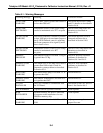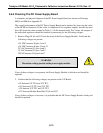
Teledyne API Model 401 O
3
Photometric Calibrator Instruction Manual, 01124, Rev. J2
9.6 Troubleshooting Individual Sub-Assemblies And
Components
The following sections provide troubleshooting/check-out methods for the specific sub-
assemblies and components of the Calibrator.
9.6.1 Troubleshooting Flow Problems
When troubleshooting flow problems, it is a good idea to first confirm that the actual flow and
not the flow-meter is in error. If available, use an independent flow meter (rotameter or mass
flow meter) to measure flow(s). Sample flow can be measured at the inlet port at the optical
bench and O
3
generator flow can be measured at the outlet of the O
3
generator. If no independent
flow meter is available, placing a finger over an inlet port and feeling for a vacuum will at least
give an indication whether flow is present.
If the independent flowmeter shows the flow to be correct, check the Pneumatic Sensor Board as
described in Section 9.6.5.
In general, flow problems can be divided into 3 categories:
1. Flow is zero (no flow).
2. Flow is greater than zero, but is too low, and/or unstable.
3. Flow is too high.
Figure 1-1 in this Manual provides a schematic diagram of the Flow in a Model 401.
Flow Is Zero
1. Confirm that the sample pump (sample flow) and/or O
3
GEN pump, (O
3
GEN flow) are
operating (turning). If not, check the 115V power to the pump. If the pump does not operate
with 115V present at its terminal, replace the pump. Check for plugged pneumatic lines,
filters, or orifices.
Low Flow
1. Check for leaks as described in Section 10.3. Repair and re-check.
2. Check for dirty sample filter or dirty orifice filter(s).
3. Check for partially plugged pneumatic lines, orifices, or valves.
High Flow
1. The most common cause of high flow is a leak around an orifice.
9-9


















